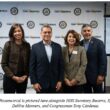Varied opinions presented at D Block hearing
Myriad ideas and alternatives to the FCC’s public-private partnership model for building a nationwide broadband network for public safety were offered during a four-hour hearing this week, reinforcing questions whether the commission will be able to pass rules regarding the 700 MHz D Block this year.
Commissioners and witnesses generally agreed that a public-private partnership model provides the greatest potential for delivering broadband applications to public safety, given the fact that Congress has provided no indication that federal funding for such an endeavor will be available. However, opinions differed considerably regarding the best structure for such a partnership.
Even within the public-safety panel, there were differences. New York City Fire Chief Salvatore Cassano and Charles Dowd, deputy chief in the New York City police department, said the FCC’s previous notion of a nationwide license should be scrapped. Instead, they recommended that the public-safety broadband spectrum be given to public-safety agencies to build mission-critical voice and data networks that would be responsive to local needs and not be compromised to meet the economic needs of a commercial partner.
While such an approach could work in areas like New York City that can generate significant tax revenue to build their own systems, it would not work as well in less populous regions, said Robert Gurss, director of legal and government affairs for the Association of Public-Safety Communications Officials (APCO).
“I think it’s going to be extremely difficult to build the infrastructure for the relatively small numbers at issue [in rural areas],” Gurss said. “If it’s a national network with a commercial element to it … I think that builds a better economic case for that.”
On several occasions, FCC commissioners questioned whether public-safety agencies would subscribe to a national broadband network if it was built—something Cassano and Dowd openly doubted New York City would do. But Steve Proctor, executive director of the Utah Communications Agency Network (UCAN), noted that UCAN faced similar questions when it was started but has grown from 4000 users to 20,000 users during the last seven years.
“If this [broadband] service were available and if one agency purchased it and was satisfied with it, it would sell itself to other agencies,” Proctor said. “I think it’s that way with most public-safety services.”
Gurss echoed this sentiment, noting the financial limitations of many public-safety agencies to build private broadband networks.
“For a lot of them, the option is not, ‘Use this network or build our own.’ It is, ‘Use this network or not do anything,’” Gurss said. “For many, that will be their only option.”
With this in mind, it is important that a workable public-private partnership plan be devised, said Harlin McEwen, chairman and CEO of the Public Safety Spectrum Trust (PSST).
“We cannot come this close and let slip away what may be a once-in-a-lifetime opportunity to address the communications requirements of the nation’s emergency responders,” McEwen said.
Meanwhile, representatives of the nation’s largest wireless carriers—AT&T and Verizon—said the FCC should give a public-safety licensee the 10 MHz of D Block spectrum to combine with 10 MHz of public-safety broadband spectrum. The licensee should then conduct a request-for-proposal (RFP) process to establish regional commercial partners that would have to agree to build their networks to interoperable standards, they said.
Most legal experts believe the FCC lacks the authority to take such action on its own, meaning Congress would have to pass a law specifying that the RFP model could be used. While public-safety officials have expressed concern that getting Congress to act on this matter would take at least a year, AT&T and Verizon believe it could happen.
“We do not believe that the need for legislative action should be viewed as an insurmountable barrier to accomplishing what is needed to ensure effective public-safety communications—if Congress determines that a reallocation is in the best interest of the country,” said Don Brittingham, Verizon’s assistant vice president for public affairs policy and communication.
To avoid the concerns associated with legislative action, the FCC should consider auctioning the spectrum in a manner that would provide commercial partners with the greatest amount of flexibility, said Larry Krevor, Sprint Nextel’s vice president of spectrum. After establishing a “baseline” of public-safety network performance, bidders would receive bidding credits for agreeing to increase coverage or improve reliability, he said.
“This is something that the commission can do now, make it so it attracts commercial bidding and makes it so we can get this started,” Krevor said.
Before any approach can be determined, the FCC must agree on rules for the D Block. But the wide variety of opinions expressed during the hearing could make it difficult for this FCC to pass rules before a new administration makes its appointments to the commission.
Commissioner Michael Copps said “we’re not even close” to having the kind of technical and financial data necessary to make an informed decision and expressed concern that “the public-safety community is of many different minds—too many—when it comes to approaching this great challenge.” For these reasons, Copps said he does not believe the FCC should rush its decision.
“I’m still for an expeditious auction and action, but only after we get it right,” he said. “Only after public safety demonstrates what it really requires and explains who and what it brings to the table. Only after the private sector has waded into what works and doesn’t and has laid out a clear path that holds the probability of attracting a viable commercial partner to build a viable public-safety network.”

















